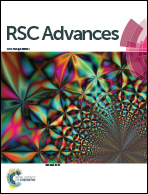Selective growth of fullerene octahedra and flower-like particles by a liquid–liquid interfacial precipitation method for super-hydrophobic applications†
Abstract
We demonstrate a simple, anisole/IPA interfacial precipitation of flower and octahedron-like fullerene micro-crystals using a liquid–liquid interfacial precipitation method. Both the flower and octahedron-like fullerene micro-crystals showed super-hydrophobic nature with a high water contact angle of 158.8°. While the other C60 nanostructures including nanowhiskers, nanosheets and nanorods do not show significant water contact angle. To the best of our knowledge, this is higher than literature reported values for pure C60-based nano/micro crystals. This clearly indicates that these crystals are promising candidates for super-hydrophobic applications.


 Please wait while we load your content...
Please wait while we load your content...